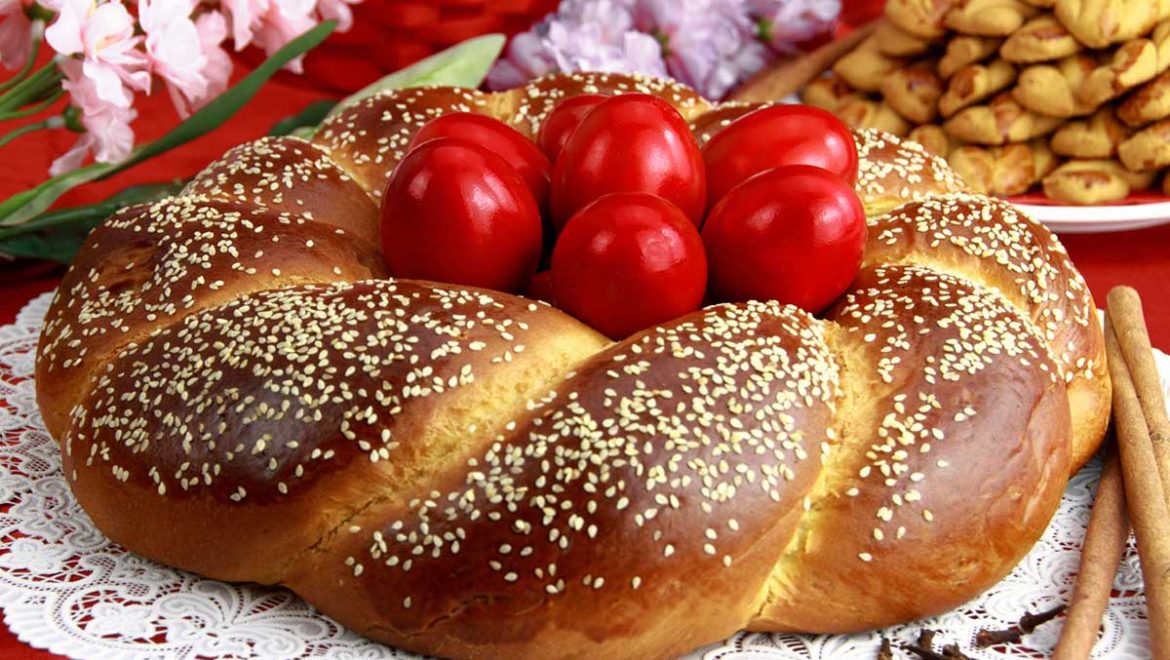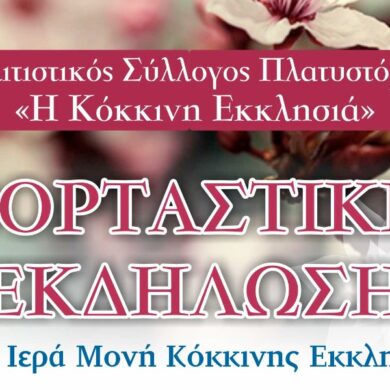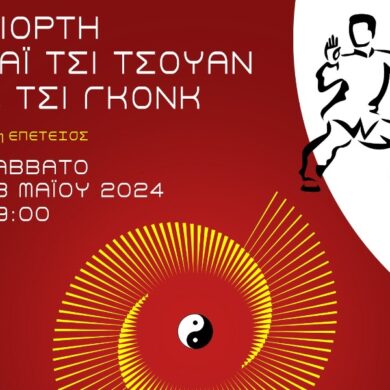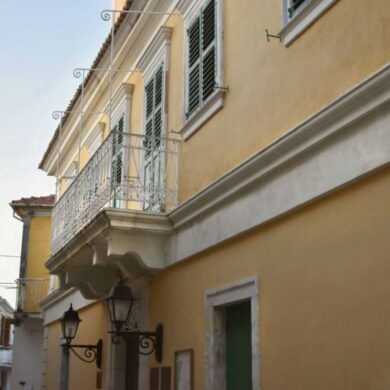By Evie Voutsina
The Easter rituals in Lefkada
Everything at the right time, because … that’s how it should be
The holiday fever began on Lazarus Saturday. The children fashioned a wooden cross, wrapping the back with white cheesecloth, decorated it with gillyflowers and various coloured flowers so that it had a human shape. They carried a little basket also decorated with flowers, for treats to be put in it. In town this was usually money, in the villages they also gave eggs or olive-oil cookies.
A fish stew was mostly the meal for Palm Sunday, made with fresh fish or salt cod. Fried fish with garlic purée was also customary. It was significant on that day to fetch branches home from church. The Lefkadian branches were not a plain sprig of bay leaves as in most places. It was a pretty bouquet of olive, bay, sage, rosemary and a long palm frond in the middle. The parishes prepared one for each parishioner. Some have the skill to weave the palm frond into a cross higher at the top of the bunch.
The first days of Holy Week were always devoted to cleaning and preparing the home. Our mothers whitewashed the whole house, scrubbed the wooden floors and coloured them with a yellowish dye.
On Maundy Thursday the eggs are dyed, cookies baked and the customary visit to the cemetery is paid for the memorial service. The usual food for that day is a pie made with greens, and mussel risotto.
On Good Friday there is no cooking or laying the table, only snacking on finger-food. The procession of the Bier (Epitaphios) is the centre of interest. In the morning it is decorated with flowers brought from the gardens, principally and best are mauve gillyflowers and white lilies. After the church service, the procession … it is a day of devoutness for all.
On the morning of Holy Saturday, as soon as the bells are rung for the First Resurrection, lemon leaves are scattered in church. All the housewives come out to smash a clay pot to pieces with force. This is a custom found with variations in all the Ionian Islands.
It is then the turn of the person in charge of slaughtering the lamb. It is done next to the threshold of the house and the sign of the cross is made with the blood at the top and the sides of the front door. When the carcass has been skinned and prepared, the housewife undertakes to clean the intestines to make them into a plait and the tripe that will be made into a thick white soup to be eaten after the Resurrection service.
“On Good Friday the baker shops sold flat loaves of bread (lagana) that was suitable for the day’s food: olives, halva, radishes, broad beans cooked with coarse salt and oregano – sold in the market by Lavranos – tarama (salted fish roe) with lemon juice only, etc. In Lefkada on that day they did not lay the table; snacks without oil were eaten standing up.”
Told by Anthoula Gourgarioti-Thermou from Lefkada
For the priest
“On the morning of Maundy Thursday we used to take along an offering for the priest. This had to be done without fail. In the old days priests were not paid a salary and were dependent on the assistance of the faithful. At Easter they also put out a tray which was called a ‘voluntary’ (contribution). And all the parishioners would put in what they could afford, for the priest.”
Told by Mantho Asprogeraka from Fryas
The Easter food in Lefkada
Patsalikia, lamb tripe soup for Holy Saturday
Sophia Stavraka, Karya
This soup was often made on Sunday evening, whilst on Holy Saturday after the Resurrection service, a few intestines were fried for a snack.
Materials:
the lamb’s intestines and stomach
the feet half the liver and lights
1 large bunch of fresh garlic
salt and pepper
2-3 eggs
the juice of 2-3 lemons
Preparation: Wash the intestines scrupulously as well as the stomach which is blanched in boiling water. Also blanch the offal. Make a plait of the intestines and chop all the rest finely. Boil them without sauteing. Add the garlic in fine slices. Season, and when cooked, thicken with beaten egg and lemon juice. The soup can be as thick as desired. Cut up the plait and put it in the serving dish, pouring the soup over it.
Interesting stuffing for baby goat
Nitsa Voukelatou, Hortata
I find tempting a tip I was given by Mrs. Nitsa, whose father-in-law put orzo in the belly of the kid. She her-shelf didn’t like it, but my experiment showed that it is special taste. Like a ghivetsi (a dish of a kind of pasta with meat, named after the cooking-pot it is made in), let’s say, sealed in as it was sewn into the belly of the carcass, redolent of garlic and fennel, cooking in the kid’s fat. Other ladies present said they had heard of it but did not known how to make it.
If you intend to venture it, put 2 cups orzo in 4 cups boiling water and boil until the water is absorbed. Season and put it in the belly of the baby goat with chopped fennel and garlic and sew it closed. When roasted the orzo may be compacted. Take two forks and fluff it.
Frygadelia
Leonidas Voutsinas, Lefkada
A proper frygadeli requires lamb’s liver. Veal liver is an emergency measure.
Materials:
2 lamb’s livers (or 700 gr veal)
2 lamb’s cauls
salt and pepper
ground allspice
very little grated garlic (optional)
Preparation: Chop the liver into uniformly sized pieces of about the size of half a box matches. Dust with the seasonings. Soak the cauls for a short while in hot water. Cut them into lozenge-shaped pieces to wrap each piece of liver, leaving the edges free.
Thread the fricadelles onto a short metal skewer, making sure the cauls are pinned where they overlap so as no to come undone when grilled.
Put them on a grill over the embers. Do not overcook but they must definitely not be underdone. The cauls melt during the cooking and the liver does not dry.
Make sure of some good bread and strong wine with them. They will be needed!
Tzatziki or ‘skordalia’: a condiment to accompany the Easter baby goat
We make this in Pigadissianous at Easter and call it tzatziki – in those days we didn’t know the real tzatziki, the kind with yoghurt – this is made in the big stone mortar. Boil potatoes and crush them in the mortar with salt, pepper and olive oil. When the potatoes are pureed, add plenty of chopped fresh garlic and a small glass of milk, boiled but cold. It should have the consistency of tzatziki; this is why you need not use all the milk so as not to make it runny. It is served with the roast.
Told by Olga Politi from Pigadisianous
Kokoretsi
Leonidas Voutsinas, Lefkada
Materials:
the lungs and heart of a lamb
the lamb’s innards and a little chopped fat
salt and pepper
a little allspice
Preparation: Wash a string of lamb’s intestines well, inside and out. Chop up the lungs, heart and pieces of fat after they have been well washed and thread them onto a spit. Season. Fix the end of the intestine at the point of the spit where the pieces come to an end. Thread the intestines over them all the way to the other end and back again, fixing the ends each time. You now have lines of intesines parallel to the spit. Then, from the top end, begin twisting them along the whole length in a direction perpendicular to the spit. Finish at the bottom and fix the intestine so it does not come undone while cooking.
Season the outside lightly before roasting.
Spit-roasting is the same as for lamb, that is at first fairly high over the embers so that it is not scorched on the outside before the interior is cooked. If the spit is not turned by motor, it needs rhythmical and constant turning by hand.
Easter cookies (Koulourakia paskhalina)
Evanthia Mataragga, Lefkada
Materials:
8 eggs
1 cup (230 gr) melted butter
1 scant cup lukewarm milk
½ kg sugar
1 oz. ammonia (28gr)
2 doses vanilla
as much soft white flour as it will take (1,300-1,400gr)
Preparation: Beat the eggs (yolks and whites) with the sugar until white. Add the butter and continue beating. Then disolve the ammonia in the milk and add to the mixture with the vanilla. Begin adding flour, kneading with your hands. This is the crucial moment. There must not be more flour than necessary or the cookies will be hard. Try a piece, and as soon as it can be rolled out it is ok. There will most probably be flour left over. Cover the dough and let it rest for half and hour and then rol out to the desired thickness. Line the baking pans with greaseproof paper, butter them lightly and bake at 180ο C they are light gold on top and bottom.
Note: The secret of success for all cookies is not to ‘overload’ them with more flour than necessary. Always let the dough rest before shaping. If necessary after it has rested, dust with a little more flour.
More Easter recipes at «The cookery of Lefkada» by Evie Voutsina Fagottobooks 2008




